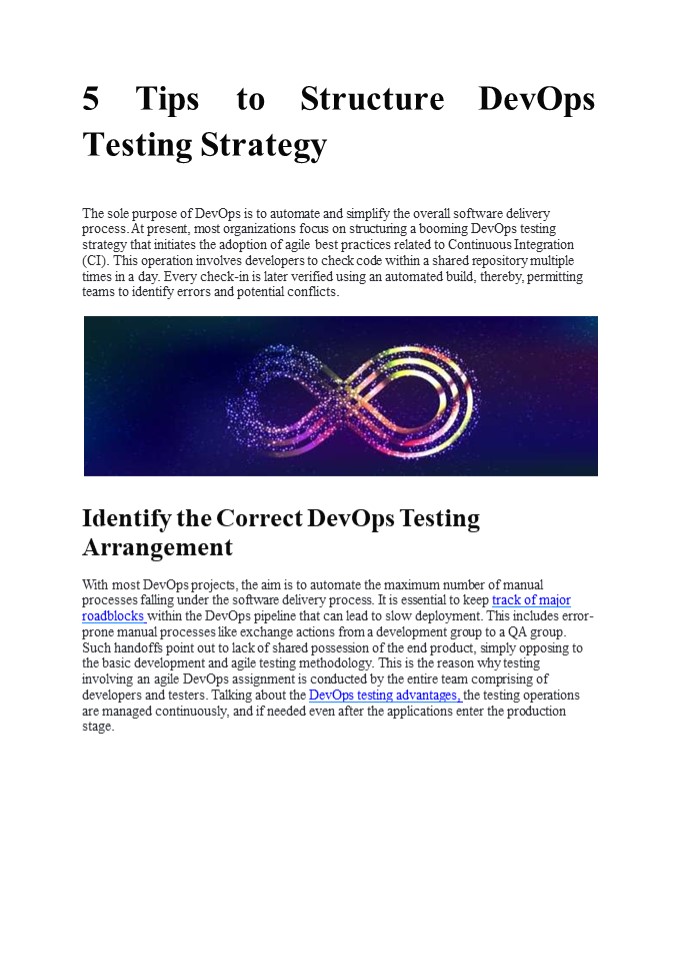5 Tips to Structure DevOps Testing Strategy - PowerPoint PPT Presentation
Title:
5 Tips to Structure DevOps Testing Strategy
Description:
5 Tips to Structure DevOps Testing Strategy – PowerPoint PPT presentation
Number of Views:0
Updated: 25 August 2022
Slides: 6
Provided by:
Zoe_Gilbert
Category:
Medicine, Science & Technology
Tags:
Title: 5 Tips to Structure DevOps Testing Strategy
1
5 Tips to Structure DevOps Testing Strategy
The sole purpose of DevOps is to automate and
simplify the overall software delivery process.
At present, most organizations focus on
structuring a booming DevOps testing strategy
that initiates the adoption of agile best
practices related to Continuous Integration
(CI). This operation involves developers to check
code within a shared repository multiple times
in a day. Every check-in is later verified using
an automated build, thereby, permitting teams to
identify errors and potential conflicts.
Identify the Correct DevOps Testing
Arrangement With most DevOps projects, the aim is
to automate the maximum number of manual
processes falling under the software delivery
process. It is essential to keep track of major
roadblocks within the DevOps pipeline that can
lead to slow deployment. This includes error-
prone manual processes like exchange actions from
a development group to a QA group. Such handoffs
point out to lack of shared possession of the end
product, simply opposing to the basic
development and agile testing methodology. This
is the reason why testing involving an agile
DevOps assignment is conducted by the entire team
comprising of developers and testers. Talking
about the DevOps testing advantages, the testing
operations are managed continuously, and if
needed even after the applications enter the
production stage.
2
Must Read Role of Software Testing in DevOps
How to Create a DevOps Testing Approach? Creating
a suitable DevOps testing strategy requires a
careful assessment of the application or
software. Further, there is a blend of several
important facets that should be put in place to
plan a proficient testing arrangement.
Let us focus on five key tips which help
structure a successful DevOps testing
strategy. 1. Prioritize Soft Skills One of the
prime challenges faced by testers is the adoption
of DevOps centers focused on soft skills. In
simple terms, DevOps does require testers to get
involved in multiple testing phases during the
software development Lifecycle. Therefore, you
need to flex communication among testers and
further merge skills which they havent
essentially used in the past.
3
For instance, while managing a DevOps
environment, testers are required to attend a
planning session to communicate freely with
developers about how what needs to get tested.
- Concentrate on Fundamental Coding Skills
- Apart from better soft skills, testers are also
required to focus on basic coding skills. This is
important to uplift their great role in the
whole software development lifecycle. Talking
about DevOps, testers are responsible to
maintain the quality of the product as well as
the process quality so as to successfully launch
that product in the market. As a fact, testers
are like doorkeepers who move the software from
one space to the other. - Some of the prime responsibilities of the testers
about fundamental skills are - They must check build logs, establish proper
functioning of automated tests and comprehend
how the software will operate at a much-rooted
level - Furthermore, testers should eagerly get involved
with the delivery process to guide the software
to pass the development lifecycle at a faster
rate. This action leads to produce a superior
quality end product
4
3. Emphasis on Test Optimization For controlling
a swift DevOps space, test automation is a basic
necessity. In these modern times, there is a
need to think vast and allow crucial changes to
enhance test automation processes. You need to
optimize the overall testing strategy for reaping
satisfactory results. According to experts,
solely stressing on test automation without any
measures for optimizing the DevOps testing
strategy can limit the efficiency of the selected
tool. On the other hand, if test optimization
actions are systematically managed, they help
enhance efficiency by activating the correct
collaboration of unit, integration as well as
functional automation in harmony with manual
testing.
Must Read 8 DevOps Trends to be Aware of in 2020
4. Timely Completed Automation Delaying to
address a problem can prove dangerous in the long
run. Hence, you should not let a problem worsen
in the DevOps world as it can escalate quickly.
Such a scenario can arise if you run numerous
manual tests instead of managing an automated
approach. To cure this situation, it is sensible
to implement frameworks that authorize automated
tests to get completed before the software
passes onto the production phase. One way to
achieve it is through layering a combination of
Test Driven Development (TDD) along with Behavior
Driven Development (BDD) for ensuring
testability, greater efficiency, and advance
collaboration.
5. Cloud Utilization For several organizations,
DevOps heavily depends on cloud infrastructure
which allows practitioners to stipulate and
request resources. There is no compulsion for the
cloud to be Amazon Web Services. The creation of
an internal private cloud is very well
received. There have been cases when enterprises
planning to uplift DevOps have struggled with
legacy infrastructure that at times avoids
interfering with advanced tools. However, in most
cases a transition like this transforms as a
requirement for the successful adoption of DevOps
testing strategy.
5
This write-up presents a profound analysis of the
importance of a correct DevOps testing strategy.
The pointers mentioned above are of great help
that streamlines the testing process and ensures
a hassle-free action for software delivery. You
can consult professional software testing
company.., ImpactQA for receiving better insight
about an effective DevOps testing strategy.































